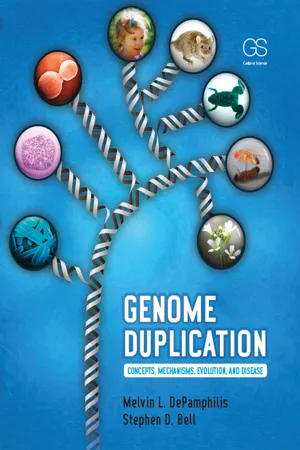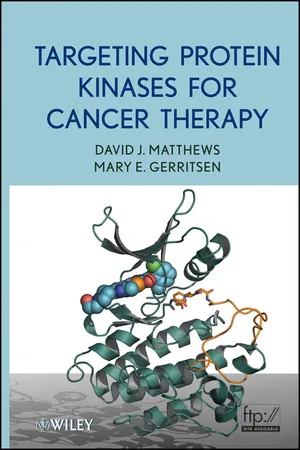Biological Sciences
Cell Cycle Checkpoints
Cell cycle checkpoints are control mechanisms that ensure the accurate progression of the cell cycle. They monitor DNA integrity, cell size, and other factors to prevent the division of damaged or incompletely replicated cells. Checkpoints act as regulatory points, pausing the cell cycle to allow for repair or halting progression if necessary, thereby maintaining genomic stability and preventing the proliferation of abnormal cells.
Written by Perlego with AI-assistance
Related key terms
6 Key excerpts on "Cell Cycle Checkpoints"
- eBook - ePub
- Melvin DePamphilis, Stephen D. Bell(Authors)
- 2010(Publication Date)
- Garland Science(Publisher)
Chapter 13 CHECKPOINTSIn the previous chapter, we learned that cell-division cycles are controlled by a series of feedback loops that ensure a linear progression of events from cell growth to genome duplication to cell division. In addition, eukaryotic cells employ at least four mechanisms (Figure 12-12 ) to prevent DNA from undergoing more than one round of replication in a single cell cycle, and at least four mechanisms (Table 12-6 ) that permit some eukaryotic cells to bypass these controls and duplicate their nuclear genomes more than once without undergoing cytokinesis (termed developmentally regulated polyploidy). Here we describe the cell’s police force, mechanisms that check the cell’s progress at various points along the road to cell division. These cell-cycle checkpoints, as Leland Hartwell called them in 1989, are surveillance mechanisms that arrest the cell cycle at specific stages in response to problems either in chromosome replication or in cell division. They ensure that cells do not begin genome duplication before they have produced the components required for its completion, that DNA damage will not derail the replication process, that cells will complete genome duplication before attempting to divide, and that each cell receives a complete set of chromosomes during cytokinesis. Checkpoints presumably exist in all living organisms, although only those in bacteria and eukarya (primarily yeast and mammals) have been characterized extensively.Cell-cycle checkpoints sense an imbalance in the normal flow of events and then respond by blocking the transition to the next event (Figure 13-1 ). Based on the event they sense and on the transition they block, cell-cycle checkpoints fall into three groups: those that restrict cell growth, those that sense changes in DNA structure, and those that sense changes in mitotic structures. Although checkpoints are not essential for cell division, they are essential for the existence of living organisms. When checkpoints are eliminated by mutation or bypassed by other means, the results are infidelity of chromosome transmission, increased susceptibility to agents that damage DNA, and cell death. Inactivation of checkpoint pathways leads directly to genome instability, and genome instability leads to cancer. Given the differences in their genetic complexity (Table 1-4 ), it comes as no surprise that the complexity of checkpoints increases from bacteria to yeast to simple metazoa to complex metazoa such as humans. Nevertheless, common principles are evident. Both bacteria and eukarya have a restriction checkpoint and at least one DNA damage checkpoint (Figure 13-2 ). Moreover, these two checkpoints sense the same defects and respond in analogous ways, even though the pathways and proteins involved differ markedly (Table 13-1 - eBook - ePub
- John E. Niederhuber, James O. Armitage, James H Doroshow, Michael B. Kastan, Joel E. Tepper(Authors)
- 2019(Publication Date)
- Elsevier(Publisher)
The cellular processes required for transition through the different cell cycle phases are controlled by the action of regulatory pathways and mostly are driven by the expression of specific cyclins and the activation of cyclin-dependent kinases. These transitions are monitored by signaling pathways known as the Cell Cycle Checkpoints (represented by blue columns) that function to arrest the cell cycle at different phases (G 1 /S, intra–S phase, G 2 /M) in the presence of DNA damage. In addition, the spindle assembly checkpoint (SAC) delays the exit from mitosis in the presence of defective chromosome alignment by inhibiting the degradation of cyclin B1 and the subsequent inactivation of cyclin-dependent kinases. Progression throughout the different phases of the cell cycle depends on the activity of key molecules that drive transcription, translation, or the structural changes required for cell division (Table 4.1). A large number of these changes are modulated by protein phosphorylation and dephosphorylation, but other molecular processes such as SUMOylation, acetylation, or ubiquitin-dependent protein degradation are crucial for ordered cell cycle progression - eBook - ePub
- Sayali Mukherjee, Somali Sanyal, Sonia Chadha(Authors)
- 2018(Publication Date)
- Apple Academic Press(Publisher)
Cell cycle is thus a highly complex process, which requires a tight coordination of various mechanisms that control different stages of DNA synthesis, replication, and segregation into daughter cells. This chapter has detailed the concerted and sequential activities of cyclins, CDKs, and various interdependent signal transduction pathways in maintaining the integrity and progression of cell cycle in normal cells. Concurrently, it highlights the susceptibility of cells to DNA damage by alteration in any component of cell division machinery.3.6 Summary- Normal cell cycle progression is maintained and continuously monitored by an intricate network of signal transduction pathways comprising cyclins, CDKs, CKIs, and several checkpoint gene products.
- Deregulation associated with synthesis, amplification, or mutation of cell cycle regulator proteins, tumor suppressors, and transcription factors is reported in a wide variety of human cancers. Therefore, loss of cell cycle checkpoint control is one of the principle causes of genetic instability that lead to malignancies.
- Thus, elucidating novel molecular mechanisms in cell cycle progression and checkpoint control can not only help in early detection of cancers and serve as prognostic markers but may also aid in predicting cancer susceptibility.
- Better characterization of known defects of pivotal checkpoint genes may help to reconstruct altered DNA damage responses aiding in designing targeted cancer therapeutic strategies. One such example is the cyclin-dependent kinase inhibitors. These low-molecular-weight units constitute attractive pharmacological targets for silencing or disrupting kinase hyperactivity in human cancers.
- Finally, because most of the components of human cell progression and control pathways play an equally essential role in other physiological processes like transcription, differentiation, neuronal, immunological response, and senescence, effective therapeutic strategies involving these pathways would promote better health outcomes.
KEYWORDS
- Cancer
- cell cycle
- Cell Cycle Checkpoints
- cyclin
- DNA damage
References
1. Dubrovsky, J. G. & Ivanov, V. B. (2003). Celebrating 50 years of the cell cycle.Nature,426 - eBook - ePub
Advanced Molecular Biology
A Concise Reference
- Richard Twyman(Author)
- 2018(Publication Date)
- Garland Science(Publisher)
completion of DNA replication, and replication commences after mitosis has precisely divided the DNA. The cell meets these criteria by organizing the cell cycle as a dependent series of events. Thus, if mitosis is blocked, the cell cycle arrests at the M phase until the block is removed — it does not go ahead and replicate the DNA anyway (i.e. DNA replication is dependent upon the completion of mitosis). Similarly, if DNA replication is prevented, the cell does not attempt to undergo mitosis, because mitosis is dependent upon the completion of DNA replication.A further function of the cell cycle is to coordinate the chromosome cycle with cell growth, so there is no progressive loss or gain of cytoplasm, and no cell proliferation in an unsuitable environment. Progress through the cell cycle is thus also dependent upon cell size and is regulated by nutrient availability, the presence of mating pheromones (in yeast), and the presence of growth factors and hormones (in animals).The cell possesses a number of regulatory systems which can sense the progress of the cell cycle and can inhibit subsequent stages in the event of failure. These regulatory mechanisms are termed cell cycle checkpoints, and represent intrinsic signaling systems of cell cycle control. The checkpoint mechanisms also respond to external signals so that arrest may occur in cases of nutrient deprivation or growth factor withdrawal. There are numerous checkpoints in the cell cycle, which are clustered in two major groups — those occurring at G1 and regulating entry into the S phase, and those occurring at G2 and regulating entry into the M phase (Figure 2.2 ). This clustering suggests that intrinsic and extrinsic signals may funnel into common components of cell cycle regulation. Additional checkpoints insure the orderly and dependent series of events which comprise mitosis.Figure 2.2: - eBook - ePub
- Michael C. Flickinger(Author)
- 2013(Publication Date)
- Wiley(Publisher)
Chapter 5: Cell Cycle in Bioprocesses Mariam Naciri and Mohamed Al-rubeai University College Dublin, Belfield, Dublin, Ireland The cell cycle is the name given to the process by which a cell matures, synthesizes DNA, and divides to form daughter cells. Thus the cell cycle is a fundamental process with analogous mechanisms found in all cells, from the most primitive bacterium to higher animals and plants, from the unicellular to the most complex multicellular organism. It is regulated by several ordered and directional molecular events and controlled by an elaborate system that if altered could result in physiological damage and cell death (1). Here we describe the mammalian cell cycle, highlight its importance in biotechnology, and describe some cell cycle applications in animal cell biotechnology. mammalian cell cycle; cell division; mitosis; flow cytometry; product expression 5.1 Introduction The cell cycle model (G 1 -event model) currently accepted by authors of the major cell and molecular biology books (2–5) describes the cell cycle as discrete phases controlled by cell cycle proteins interacting with each other and directing cellular events including DNA synthesis and cell division. However, the validity of this model and the interpretation of many experiments that underpin the current established view of the cell cycle and its regulation have been questioned (6, 7). The proposed alternative, the continuum model, suggests that the cell cycle does not exist as currently recognized but takes the form of a continuum from one cell division to the next, rather than discrete phases with discrete groups of regulatory proteins. A hypothetical initiator of DNA replication is synthesized by the cell during all phases of the cell cycle, and its concentration reaches a critical level that initiates DNA synthesis. Thus the cell can control its rate of division by regulating the amount of initiator - eBook - ePub
- David J. Matthews, Mary E. Gerritsen(Authors)
- 2011(Publication Date)
- Wiley(Publisher)
Figure 6.8 ). These checkpoints serve to detect DNA damage and activate DNA repair mechanisms at the sites of damage, while also propagating the DNA-damage signal throughout the cell in order to retard or block cell cycle progression. If the DNA lesion(s) can be repaired, the checkpoint signal is terminated and the cell cycle is reengaged: however, in the case of insurmountable damage, the checkpoint pathways initiate signaling programs leading to apoptosis or senescence. Several protein kinases are centrally involved in DNA-damage response signaling, and these proteins represent a double-edged sword with regard to the initiation, progression, and treatment of cancer. Tumorigenesis almost always involves defects in genomic integrity, and in early stages of carcinogenesis the DNA-damage response network acts as a barrier to tumor formation (384–386). In these nascent tumors, oncogene-induced replication stress leads to stalled replication forks and DNA breakage, activating DNA-damage checkpoint pathways and resulting in DNA repair, cell death, or senescence (387, 388). However, some cells may evade these checkpoints and develop into advanced tumors with widespread genetic defects. In such cases, genomic instability may act as an intrinsic source of replication stress and cell cycle checkpoint mechanisms may turn from hero to villain, enabling the survival, DNA repair, and productive replication of cancer cells. Furthermore, these checkpoint pathways may play a significant role in protecting tumors against the damaging effects of genotoxic therapies, and inhibition of cell cycle checkpoint mechanisms has been proposed as a strategy for increasing the efficacy of radiotherapy and chemotherapy (389, 390). Research during the past few years has dramatically increased our knowledge of the spatial and temporal regulation of cell cycle checkpoint activation by different kinds of DNA damage. Next, we review some kinases that are important for cell cycle checkpoint control, and their potential as anticancer targets.6.5.1 ATM, ATR, and DNAPKFigure 6.8Overview of DNA checkpoint signaling in response to various DNA damage modalities. See text for further details.The ATM (ataxia telangiectasia-mutated) and ATR (ataxia telangiectasia and Rad3-related) kinases are proximally involved in activating cell cycle checkpoint mechanisms in response to various kinds of DNA damage. As indicated by its name, ATM is mutated in ataxia telangiectasia (AT), a congenital disease characterized by multiple immunological and neurological defects. AT patients are also hypersensitive to ionizing radiation and predisposed to cancer, highlighting the role of ATM in modulating the cellular response to DNA damage. ATM and ATR are very large proteins, comprised of 3056 and 2644 amino acids, respectively, with the kinase domain located near the C terminus (Figure 6.9
Learn about this page
Index pages curate the most relevant extracts from our library of academic textbooks. They’ve been created using an in-house natural language model (NLM), each adding context and meaning to key research topics.





